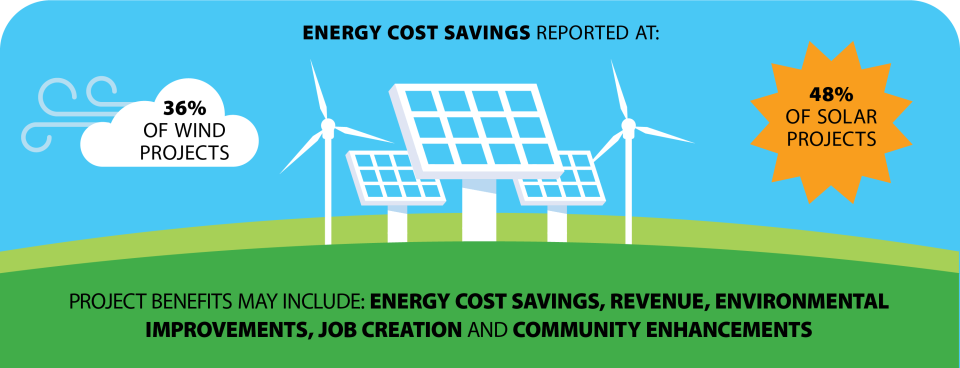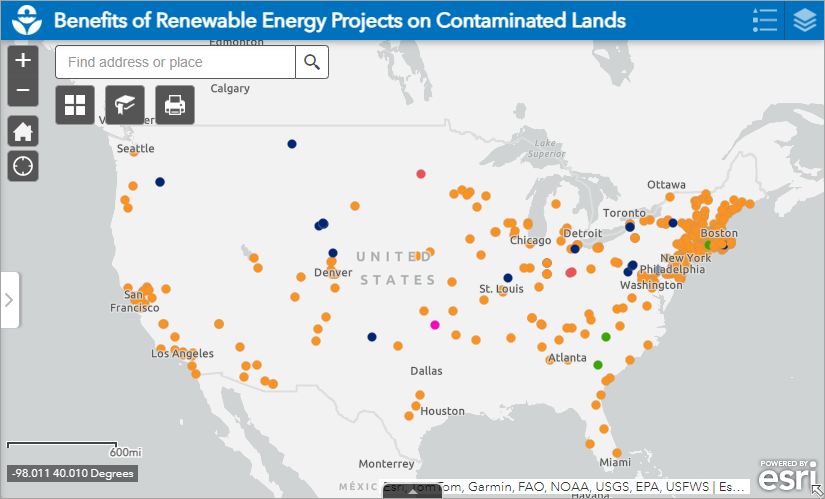Benefits Matrix
On this page:
Across the United States, communities are generating revenue, realizing energy cost savings, and creating jobs when redeveloping formerly contaminated sites with renewable energy projects. Community goals such as meeting a local clean energy objective, cleaning up a former brownfield, or protecting greenspace may stimulate action on a project. EPA, through its RE-Powering America’s Land Initiative (RE-Powering Initiative), maintains a list of economic and environmental benefits that have been publicly reported by communities and developers associated with renewable energy projects on contaminated lands.
If you are considering developing a renewable energy project in your community, the information presented here can be used to educate stakeholders on the benefits of redeveloping formerly contaminated sites. EPA’s RE-Powering Initiative has compiled the latest benefits based on publicly available information, including fact sheets, case studies and other resources that provide information on over 500 projects across the country.

Infographic states "Energy Cost Savings Reported at 36% of wind projects and 48% of solar projects. Project benefits may include energy cost savings, revenue, environmental improvements, job creation and community enhancements."
- Nearly 14% of projects report job creation. For example, the MCE Solar One project in Richmond, California supported 341 jobs and partnered with a job training program to educate and employ local residents in a variety of positions related to solar installation.
- The RE-Powering Initiative has identified benefits associated over 600 renewable energy projects on contaminated land installations currently documented in the RE-Powering Tracking Matrix.
- The March 2025 Benefits Matrix Site List (xlsx) of projects details the community benefits resulting from hundreds of renewable energy projects nationwide, including wind, solar, biomass, and geothermal. This list can be used by communities and stakeholders to: 1) help locate similar projects in specific geographic areas, and 2) cross-reference site benefit information with additional information in the December 2024 Tracking Matrix.
Benefits Matrix
The Benefits Matrix List has tabs that include the entire universe of sites or specific site types for example Superfund or landfills. Users can filter the list to identify sites by state, by owner, by capacity and several other attributes to view examples of the benefits of RE-Powering sites.
Siting renewable energy projects on contaminated properties provides many potential environmental and economic benefits. Through reuse of these sites, communities can transform a vacant or underutilized property into a facility that may help improve the local tax base, create jobs, and turn blight into an economic opportunity. This approach reuses the land while turning a potential liability into an asset that can benefit the community for decades. Publicly available, stakeholder-reported information indicates that communities, private site-owners, and consumers have saved millions of dollars in energy costs, created construction jobs, and received new property tax revenue by reusing these sites for renewable energy.
Renewable energy projects developed and maintained on contaminated land provide economic and environmental benefits, including energy cost savings, revenue generation and GHG reductions. While all RE-Powering sites provide benefits, identifying and quantifying those benefits relies on publicly available information. The underlying sources or methods used to determine quantitative benefits (either estimated or achieved) may not be readily available or clearly reported. Sources used to populate this document include publicly available EPA resources (e.g., fact sheets, case studies) or public statements made by parties directly involved with a project (e.g., town, site owner, developer, utility, federal agency).
The benefits reported and documented in the matrix may have been calculated using a variety of methods and/or expressed in different units. Consequently, a cumulative expression of the total benefits achieved by renewable energy projects on contaminated lands is not possible from publicly available sources. In addition, the specific benefits of each project can vary due to several factors, including electricity prices, site clean-up status, incentives, policies (e.g., renewable portfolio standards), development costs, availability of transmission and infrastructure, and renewable energy technology type and capacity.
Many projects report multiple benefits for a single installation. For example, the Dexter Street Solar installation in East Providence, Rhode Island: 1) generates energy credits for the Rhode Island Public Transit Authority, 2) provides annual energy cost savings that exceed $250,000, 3) creates a new source of tax revenue from underused property, 4) offsets millions of pounds of carbon dioxide emissions, and 5) produces dozens of job opportunities. Commonly reported benefits from renewable energy on contaminated lands include revenues from land leases and taxes, electricity cost savings associated with the reduced need to purchase power from the grid, job creation, and reduced greenhouse gas emissions. The following chart illustrates the types of benefits stakeholders have achieved at hundreds of installations.
List of Benefits
|
|
72 Projects Report Job Creation | Jobs include short-term job creation, such as construction workers who install the installation as well as long-term job creation, such as workers who perform ongoing maintenance for the installation. |
|---|---|---|
|
|
231 Projects Report Environmental Benefits | Environmental benefits include, for example, reducing greenhouse gases, creating and maintaining pollinator friendly habitat, and protecting open space. |
|
|
147 Projects Report Revenue Generation | Revenue includes three categories: taxes or payment in lieu of taxes (PILOT), leases or renewable energy credits (RECs). |
|
|
259 Projects Report Energy Cost Savings | Energy cost savings include benefits that reduce or offset costs of electricity. |
|
|
80 Projects Report Community Benefits |
Community benefits include community solar installations that allow community members to purchase solar power subscriptions, providing an environmentally friendly power source to those who would otherwise not have access as well as cost savings for low-to moderate-income families. |
|
|
179 Projects Report Other Benefits | Other benefits include cost savings associated with powering site clean-up (green remediation), induced economic benefits to the community resulting from jobs created (e.g., more customers for the local diner), secondary use of renewable energy installations as tools for learning and data gathering, and the ability to use renewable energy installations for distributed generation. |
Benefits Mapper – Renewable Energy Projects on Contaminated Lands
The locations of completed projects with benefits can be explored using the Benefits Mapper, just click on a location to see what benefits are associated with the site.
To open the application, click on the image below.

For more detailed project examples, see RE-Powering Success Stories.






